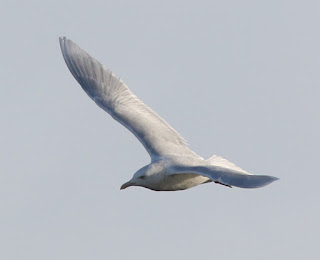This Little Auk was picked up yesterday evening in the brightly lit yard of a poultry farm near Knocknagoshel, at least 30km from the nearest coast. The owner Edwin Stryker took the bird into care and kept it overnight. This morning it was taken to the coast near Camp for release, in a sheltered bay, with plenty of potential feeding nearby and access to open ocean.
Little Auk, at the release site near Camp, 10th December 2015 (D.Farrar).
The Little Auk had perked up during the night, and by morning it was obviously ready to release.
Little Auk, near Camp, 10th December 2015 (M.O'Clery).
Ageing and sexing Little Auks is very difficult, even in the hand. Characteristics of bill depth and wing measurement can be used, though only with an accuracy of 83%, according to a 2005 paper on the subject from the Seabird Group. Just to add another layer of detail, "White or white-tipped feathers in the lesser primary coverts (LPC) occurred more frequently in juveniles than in adults, while the reverse was true for the greater secondary coverts (GPC). Only 74% of the Little Auks were properly aged on [this] basis."
If you want to explore this vexed and complex issue, make yourself a stiff drink, keep the Hedex tablets to hand, then download and read the article (in PDF format) from HERE, or alternatively, shrug your shoulders and say, "Ok then, but it's still definitely a Little Auk..."
Little Auk, Camp, 10th December 2015 (D.Farrar).
Little Auk, Camp, 10th December 2015 (M.O'Clery).
The bird was placed on a rock with a gentle slope onto the water, and after a few minutes it stretched a little, then shuffled into the incoming tide and started to make its' way out to sea.
Little Auk, Camp, 10th December 2015 (M.O'Clery).
We last saw it heading strongly away from the coast, occasionally flapping, and diving. A happy ending to this bird's (mis)adventures. Let's hope this male/female/ youngster/veteran made it.
Big shout out to Edwin for taking this bird into care - a lot of people wouldn't have bothered. Good man.


















































